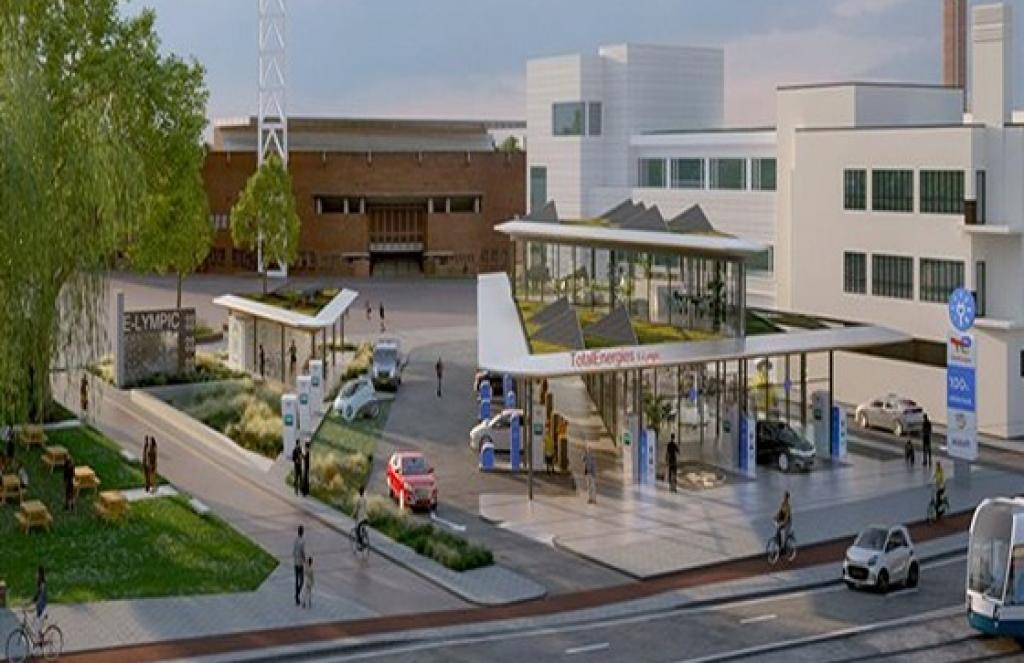Thessaloniki gets ready for its metro launch in November
The underground rapid transit lines have been under construction for almost two decades due to various project delays
 TheMayor.EU logo
TheMayor.EU logo 
A preliminary design of the first planned mobility hub in Amsterdam - E-lympic, Source: Amsterdam Municipality
The term ‘petrol station’ will become anachronistic so the facility will be called a ‘mobility hub’
With the rise of electric mobility, the view is that petrol filling stations will gradually become a thing of the past. But what’s set to replace them? The City of Amsterdam thinks it has the answer – something called a ‘mobility hub’.
The mobility hub will kind of resemble a traditional filling station, but it will instead be dedicated to servicing the needs of electric vehicles rather than fossil fuel-powered ones. It will feature facilities such as fast chargers, electric shared vehicles and other services, such as catering and workplaces.
The first one of these, called E-lympic (the name was picked following a consultation with residents) will begin to be constructed in the first quarter of next year on Stadionplein in Amsterdam Zuid. The preliminary concept can be seen in the picture; however, its final shape and outlay will still be a matter of discussion in the following months.
Amsterdam wants to make the area within the ring road an emission-free zone by 2030. To achieve this, it needs to quickly expand the number of fast-charging locations. Plus, the local government wants to reduce car ownership among Amsterdam residents.
That’s why a big part of the E-lympic mobility hub will be the availability of shared electric mobility, apart from the charging stations.
The mobility hub will make optimal use of green electricity and locally generated energy. A smart energy management system with a battery will help to minimize the load on the electricity grid.
E-lympic will serve as a test bed. Together with the AMS Institute, the City will study how useful such mobility hubs will be, and what they mean for traffic and for energy consumption. The results can serve to improve the design of future mobility hubs.

The underground rapid transit lines have been under construction for almost two decades due to various project delays

Now you can get your wine in Talence by paying directly in Bitcoin

That’s because the state has to spend money on updating the railway infrastructure rather than subsidizing the cost of the popular pass

Rethinking renewable energy sources for the urban landscape

The examples, compiled by Beyond Fossil Fuels, can inform and inspire communities and entrepreneurs that still feel trepidation at the prospect of energy transition

Now you can get your wine in Talence by paying directly in Bitcoin

The 10th European Conference on Sustainable Cities and Towns (ESCT) sets the stage for stronger cooperation between the EU, national and local level to fast track Europe's transition to climate neutrality.

At least, that’s the promise made by the mayor of Paris, Anne Hidalgo

The underground rapid transit lines have been under construction for almost two decades due to various project delays

At least, that’s the promise made by the mayor of Paris, Anne Hidalgo

Hostal de Pinós is located in the geographical centre of the autonomous region

Despite its church-y name, the district has long been known as the hangout spot for the artsy crowds

Urban dwellers across the EU are having a say in making their surroundings friendlier to people and the environment.

Forests in the EU can help green the European construction industry and bolster a continent-wide push for architectural improvements.

Apply by 10 November and do your part for the transformation of European public spaces

An interview with the Mayor of a Polish city that seeks to reinvent itself

An interview with the newly elected ICLEI President and Mayor of Malmö

A conversation with the Mayor of Lisbon about the spirit and dimensions of innovation present in the Portuguese capital














